

Catcher In The Rye, ebook, by J D Salinger. The Catcher in the Rye Study Guide. Author J.D. Salinger immortalizes teen angst – MOVE Magazine. Guide Column: Author J.D.
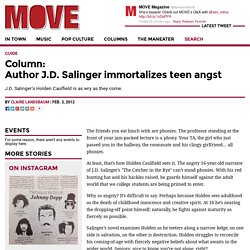
Salinger immortalizes teen angst J.D. Salinger’s Holden Caulfield is as wry as they come. Events For some reason, there aren't any events to display here. More stories The friends you eat lunch with are phonies. At least, that’s how Holden Caulfield sees it. Why so angsty? Salinger’s novel examines Holden as he teeters along a narrow ledge; on one side is salvation, on the other is destruction.
"The Catcher in the Rye" spans exactly three days and 224 pages, but that tiny timeframe contains Holden’s personal journey of self-discovery — a series of moments in which he pinpoints his issues with adulthood and moves beyond them. Use of Language in Catcher in the Rye, English - CollegeTermPapers.com. Notes on The Catcher in the Rye Themes. Chapter 1 Lies and Imagination 1: Holden, in his wish to "feel some kind of good-by" (pg. 16) before he leaves Pencey, shows himself to be concerned with the authenticity of his own feelings.
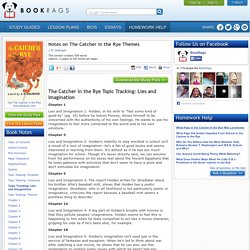
He wants to use his imagination to feel more connected to the world and to his own emotions. Chapter 3 Lies and Imagination 2: Holden's inability to stay enrolled in school isn't a result of a lack of imagination--he's a fan of good books and seems interested in learning from them. It's almost as if he has too much imagination for school. Chapter 5 Lies and Imagination 3: The report Holden writes for Stradlater about his brother Allie's baseball mitt, shows that Holden has a poetic imagination.
Chapter 14 Lies and Imagination 4: A big part of Holden's trouble with movies is that they pollute peoples' imaginations. Chapter 18. Ducks, Fish, and Other Wildlife in The Catcher in the Rye. Holden just can’t let up about those ducks.
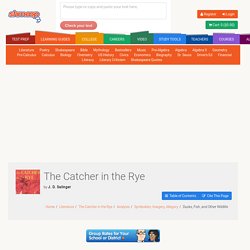
He asks his first cab driver if he “happen[s] to know where they go, the ducks, when it gets all frozen over? Do you happen to know, by any chance? " (9.4); and throws same question at a second cab drive a few chapters later (12.8). In his big breakdown moment, he stumbles drunkenly around the park looking to see “what the hell the ducks were doing, see if they were around or not” (20.38). The Catcher in the Rye Themes. Hatred of Phonies "Phonies" is arguably the word most often associated with J.
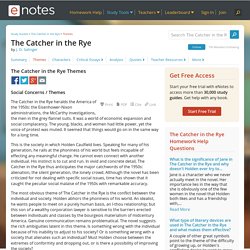
D. Salinger's The Catcher in the Rye. Sixteen-year-old Holden Caulfield has a thirst for authentic experience, and the fake behavior and attitudes he finds among other people sicken him. The first time the term occurs is when Holden describes the headmaster of Pencey Prep as a "phony slob. " He rejects the school's high-faluting statements about how it molds "splendid, clear-thinking young men" as mere advertising propaganda. Phoebe. Holden's 10-year-old sister, Phoebe, is bright, pretty, mature beyond her years, sane, and his most trusted link to family.
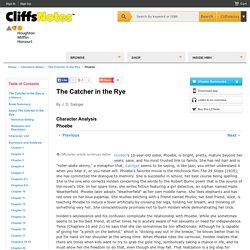
She has red hair and is "roller-skate skinny," a metaphor that, Salinger seems to be saying, is like jazz; you either understand it when you hear it, or you never will. Phoebe's favorite movie is the Hitchcock film The 39 Steps (1935); she has committed the dialogue to memory. Does Catcher In The Rye Brainwash People? Bloomsday-2012.jpg (JPEG Image, 1056 × 1632 pixels) - Scaled (61%) Bloomsday in Dublin: A Celebration of the Life of James Joyce. If you’re in Dublin on or around June 16, you may think you’ve been transported back to the early 1900s with ladies and gentlemen in Edwardian frock coats and bustling dresses walking the city streets.

Actually, you’re witnessing the yearly celebrations of the life of James Joyce and his epic work, “Ulysses.” Ardent fans dress up in period costume and re-enact scenes from the book at their exact locations. Reading Ulysses on Bloomsday Bloomsday in Dublin: A Movable Feast. Sebastian Barry reads 'Eveline' by James Joyce. Finnegans Wake has defeated me, although guilt has driven me to dip into it over the decades.
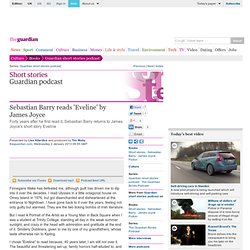
I read Ulysses in a little octagonal house on Omey Island in 1976, but got disenchanted and disheartened at the entrance to Nighttown. I have gone back to it over the years, feeling not only guilty but alarmed. They are the two ticking bombs of Irish literature. But I read A Portrait of the Artist as a Young Man in Back Square when I was a student at Trinity College, standing all day in the weak summer sunlight, and crazy in the head with admiration and gratitude at the end of it. Similarly Dubliners, given to me by one of my grandfathers, whose taste otherwise ran to Kipling. I chose "Eveline" to read because, 40 years later, I am still not over it.